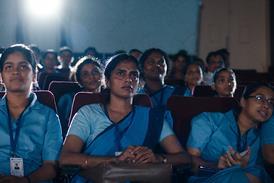South Korea is no stranger to talk of a crisis in the film industry, even in the midst of years of swollen admissions, record-breaking local hits and rising exports.
However, a recent study from the Korean Film Council (Kofic) estimates the average local film in 2007 to have earned back just 39% of its budget. In 2006, the average film earned 77% of its budget.
Only 10 Korean films, including the romantic comedy 200 Pounds Beauty and thriller Voice Of A Murderer, passed the 2 million admissions break-even mark in 2007 from more than 100 releases.
Production costs are rising: the average production and p&a spend on a Korean film was $5.4m in 2006, shooting up to $6.5m in 2007. But the films simply did not connect with audiences.
In 2007, theatrical admissions, which account for 80% of the industry's total profits, dropped for the first time in 11 years - albeit from a record high of 166 million in 2006 - to 157 million, according to leading exhibitor CJ CGV (2007 remains the second-highest year of all time by admissions).
The market share of local films fell 27.5% year on year to 50.8%, the lowest since 2002.
Admissions for non-Korean films rose from 58 million in 2006 to 77 million in 2007. Although the halving of the screen quota undoubtedly played a part, there has also been talk of a creative drought. After all, since the late 1990s, Korean, rather than Hollywood, films have driven the boom.
'Korean films have grown rapidly in the past 10 years, with fresh material and an expanding regional market. But of late, audience perception of local films has grown worse and the film industry needs to keep up with audience trends,' says Choi Geon-yong, a Lotte Entertainment executive and panelist at a recent Kofic forum on investment profitability.
Korea's unusually high dependency on theatrical returns (theatrical accounts for 25%-40% of a film's total revenues in most territories) is due to the country's virtually non-existent video/DVD markets. Illegal downloads are blamed for this - South Korea is one of the most plugged-in countries in the world. Anti-piracy campaigns are on the rise, led by star actors and directors such as Bong Joon-ho.
One of the biggest problems of the past two years has been a surplus in local productions, spurred by an influx of capital - most notably the entrance of telecoms giants KT and SKT - backdoor-listing mergers, and investors eager to see the results of their participation in the film sector. As a result, too many films have been greenlit without qualified scrutiny or preparation.
The rising power of stars
Producers became dependent on star casting to convince investors and to justify rising p&a spends. A-list actors were able to command fees of $600,000 a project ($400,000 for actresses), not including bonuses and participation deals. However, the disappointing performance of films such as The Restless, which starred Jung Woo-sung and Kim Tae-hee, has forced the industry to learn the hard way that deploying a star name is not always enough to win over audiences.
On a positive note, innovative films with interesting stories and no big stars have benefited from some investors' desire to prove their mettle. KM Culture's $4.7m 200 Pounds Beauty, has become one of Korea's 10 most successful films of all time and made a star out of Kim Ah-jung.
'It would have been hard to get financing in other years without A-list casting,' says the film's producer, Roh Eun-hee, of the financing climate of 2006.
Following an agreement made last July by 10 Korean film organisations - dubbed the 'Great Compromise' - producers and talent managers are co-operating to bring down costs.
There is now a drive to pay directors and stars from profits rather than earnings, with stars agreeing to lower fees.
Indeed, leading investor/distributor CJ Entertainment is adopting this new financing structure for two big-budget projects in 2008, director Jung Ji-woo's Modern Boy and Kim Yoo-jin's Singijeon: The Diving Arrow Machine.
A creative drought'
With old-school producer-investors seemingly falling out of touch with audiences, and the rise of a new generation of film-makers, the industry recognises the need to nurture development executives and producers.
'We need to be less dependent on the creativity of star directors,' suggests Lee Hyeon-seung, vice-chairman of Kofic and director of Il Mare. 'We need more script incubating and more stable support for scriptwriters.'
In addition to its established pre-production support funds and scriptwriting contests, Kofic launched its first Script Sales Market in December. With established writers anchoring the event with their projects, newcomers pitched scripts to producers, with one deal being struck on the spot.
South Korea has an attentive government-funded organisation in Kofic, providing policy infrastructure and support.
In the face of an international sales downturn, the organisation is keeping awareness of the territory high by running festivals and symposiums, such as the Kanryu (Korean Wave) Cinema Festival which tours Japan.
Kofic and the Korea Export Insurance Corporation (Keic) recently signed a 'memorandum of understanding' towards the creation of a cultural export insurance specifically for films - so cementing the idea on a government-funded level that films are cultural export items that contribute to South Korea's international image.
New technology is also contributing to changes. 'Digital cinema will take a lot of the burden off distributors and that should help increase diversity at the cinemas,' says Ray Seok, senior manager at D-Cinema Korea, a new joint venture between leading exhibitors CJ CGV and Lotte Cinema.
'It will also make creative work easier. New generations of film-makers can start learning easily as amateurs with 'user-created content', and they can screen through diverse channels.
The technology will bring production investment costs down, creating a structure for a virtuous circle of creativity and quality.'
With a critical but interested public, government support and a well-educated and determined workforce that examines itself continually and looks for innovations, there is much to be hopeful about in Korea. Even veteran maestro Im Kwon-taek, with 100 films under his belt as of last year, is looking for innovations in his art and is considering digital for a possible 101st film.
Discounting the many low-budget films that have appeared on the scene, the Korean Film Council (Kofic) took a sample of 50 films last year.
Korea by numbers
The average production budget was $4.1m, with p&a spend at $1.9m, and 'other distribution and miscellaneous fees' at $490,000, bringing the total to $6.5m. In 2006, the average production budget was $2.8m, p&a $1.6m, and the total per film was $5.4m.
| TOP 10 KOREAN FILMS, 2007 | |||
| Total Budget $ | |||
| Title (Dist) | (incl p&a) | Adm | Gross $ |
| 1 D-War (Showbox Mediaplex) | $30m* | 7.8m | $52.5m |
| 2 May 18 (CJ Entertainment) | $13.6m | 6.9m | $46.8m |
| 3 200 Pounds Beauty (Showbox Mediaplex) | $7.9m | 6.2m | $38.6m |
| 4 Voice Of A Murderer (CJ Entertainment) | $7.1m | 3m | $18.7m |
| 5 Le Grand Chef (CJ Entertainment) | $5.3m | 2.9m | $20.2m |
| 6 Miracle On 1st Street (CJ Entertainment) | $6.9m | 2.6m | $16.4m |
| 7 Going By The Book (CJ Entertainment) | $5.8m | 2.2m | $14.8m |
| 8 Paradise Murdered (MK Pictures) | $5.6m | 2.1m | $14.1m |
| 9 A Love (Lotte Entertainment) | N/A | 2m | $14.4m |
| 10 Seven Days (Prime Entertainment) | N/A | 2m | $14.4m |
| * Production budget only. Source: based on preliminary figures from | |||






















No comments yet